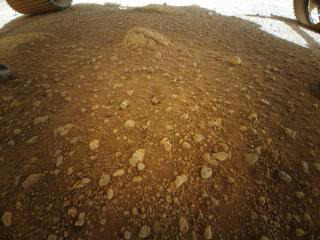Ingenuity May Not Have Flown Yet, But NASA's Mars Helicopter Nailed Its First Challenge
NASA's Mars Helicopter has survived its first night standing, alone, on the surface of Mars, and it's more than just parental concern that had engineers back on Earth worrying about Ingenuity. Deployed from the underbelly of the Perseverance rover on Sunday, the helicopter may not have made its first, record-setting flight yet, but even just getting through to this morning unscathed is an achievement.
That's because the temperature extremes on Mars can be huge, and not especially amenable to electronics. In Jezero Crater, for example, where Perseverance landed, it can get down to -130 Fahrenheit (-90 Celsius) in the evening. At those levels, electrical components can free and then crack.
At the same time, Ingenuity's batteries were also a point of concern. As anybody who has lived with an EV in a tough winter will know, cold conditions and battery capacity aren't friends. Ingenuity's batteries and electronics were protected, but it was still uncertain whether everything NASA and the Jet Propulsion Laboratory (JPL) team that manages the Perseverance project had done would be sufficient.
Happily, morning dawned, and Ingenuity appears to have survived unscathed. "This is the first time that Ingenuity has been on its own on the surface of Mars," MiMi Aung, Ingenuity project manager at the JPL explains. "But we now have confirmation that we have the right insulation, the right heaters, and enough energy in its battery to survive the cold night, which is a big win for the team. We're excited to continue to prepare Ingenuity for its first flight test."
It required not just specialist hardware, but clever use to maximize what's available on Mars. The helicopter's heaters, for example, are of course battery powered, which meant once it had deployed Ingenuity, Perseverance needed to back off quickly so as not to block the 'chopper's solar panels. It can't go too far, however, as it's the helicopter's relay for messages back to Earth.

That's already been used, even on the ground, to share some of the local color around Ingenuity. A camera mounted underneath, for instance, has shown the Martian surface it's sitting on. Eventually, it'll unfurl its rotor blades – which NASA expects to happen midway through this week – and then Ingenuity will run through various motor tests and electronics checkouts.
The current target is for the helicopter to take off as soon as April 11. That'll hopefully be the first of several flights through the so-called "Month of Ingenuity," as the little aircraft becomes the first example of powered flight on a different planet. While no specific scientific endeavors are planned, it'll be beaming back photos to show just how the whole adventure goes.
